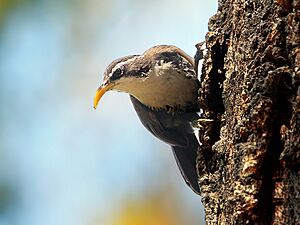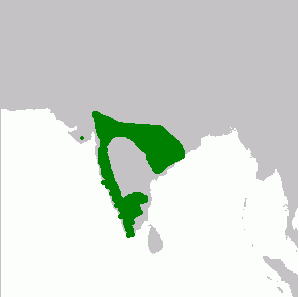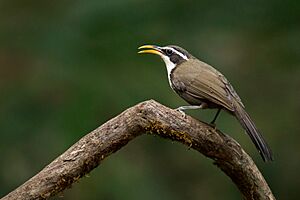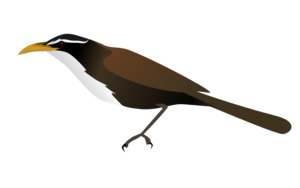Indian scimitar babbler facts for kids
Quick facts for kids Indian scimitar babbler |
|
|---|---|
 |
|
| Conservation status | |
| Scientific classification | |
| Genus: |
Pomatorhinus
|
| Species: |
horsfieldii
|
| Subspecies | |
|
P. h. obscurus Hume, 1872 |
|
 |
|
The Indian scimitar babbler (Pomatorhinus horsfieldii) is a fascinating bird found in India. It belongs to a group of birds called Old World babblers. You can find them in many different forest areas across peninsular India. These birds are often hard to see because they like to search for food in thick plants. However, you can usually hear their special calls, which often involve two birds singing a duet! Their name comes from their long, curved yellow beak, which looks a bit like a scimitar (a curved sword). This bird used to be considered the same species as the white-browed scimitar babbler from the Himalayas. But now, scientists know they are two separate species. The Indian scimitar babbler is also different from the Sri Lanka scimitar babbler (Pomatorhinus melanurus).
What Does It Look Like?
This bird is about 22 centimeters (about 8.5 inches) long. Its most noticeable feature is its long, yellow beak that curves downwards. The top part of the beak is black near its base. The bird has a striking pattern on its head. It has a long white stripe above its eye, with a wide black stripe going through the eye. Its throat and chest are white, which stands out against its dark grayish-brown back. Its underside is dark gray to black.
The Indian scimitar babbler has a wide, long tail that gets narrower at the end. Its wings are short and round, and it's not a strong flyer. You won't often see it flying in open spaces.
These birds use their long, curved yellow beaks to search for food. They dig through leaf litter (fallen leaves) and bark on trees. They mostly eat insects and berries. Even though they are hard to spot in the dense plants they prefer, they are very noisy birds. Their unique bubbling calls are often the best way to know they are nearby. The call usually starts with a loud, flute-like oop-pu-pu-pu. This is immediately followed by a krukru sound, which the female bird makes. They sing this duet perfectly together! Sometimes, birds with unusual white patches (called leucism) have been seen.
Where Do They Live?
The Indian scimitar babbler is the only scimitar babbler found in Peninsular India. This means it lives in the southern part of India, below a line that stretches between Rajasthan and Orissa.
Bird Family and Types
The Old World babblers are a big family of passerine birds. They are known for their soft, fluffy feathers. These birds live in warm, tropical areas, with the most different kinds found in Southeast Asia. The Indian scimitar babbler is very closely related to the Sri Lanka scimitar babbler. In the past, some thought they were the same species. Also, this bird was once thought to be a type of the white-browed scimitar babbler (Pomatorhinus schisticeps), which lives in the Himalayan foothills. Studies of their DNA confirm they are related.
Scientists have noticed that there are several slightly different types, or "races," of the Indian scimitar babbler. For example, the race called travancoreensis lives in the Western Ghats mountains south of Goa. These birds tend to be darker in color. The main race, horsfieldii, is found in the plains in the southern part of India. The race obscurus lives in the dry areas of the northwest (like Madhya Pradesh, Rajasthan, and Gujarat). These birds are lighter and more grayish. Another race, maderaspatensis, found in the Eastern Ghats mountains, looks somewhere in between the main form and obscurus. This race also has a shorter beak and doesn't have the black base on the top part of its beak.
The Sri Lankan form, melanurus, is now considered a full species by some experts. This is because it lives separately on an island and has different calls. However, interestingly, the Sri Lankan birds will still respond to the calls of the Indian form!
Life and Habits
The Indian scimitar babbler is a bird that stays in one place; it does not migrate. It lives in forests and areas where forests are growing back, mostly in hilly regions. They find their food, mainly insects, on the ground or on plants. They hop around on the ground, sometimes flipping over leaves or poking into leaf litter to find prey. They might also join groups of different bird species that are foraging together.
These birds usually breed from December to May. Their nest is a large, loose, round shape made of leaves. They hide it well in a bush, either on the ground or very low down. They typically lay three pure white eggs, but sometimes they lay two or four.




